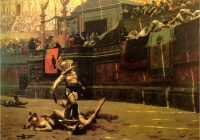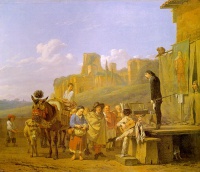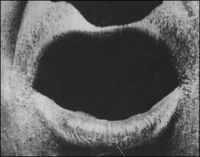Performance
From The Art and Popular Culture Encyclopedia

|
"In the earliest times of Greece, it was customary for the whole population of a city to meet on stated occasions and offer up thanksgivings to the gods for any great blessings, by singing hymns, and performing corresponding dances in the public places."--The Theatre of the Greeks (1836) by John William Donaldson "All the world's a stage, "Only animals who are below civilization and the angels who are beyond it can be sincere. Human beings are, necessarily, actors who cannot become something before they have first pretended to be it; and they can be divided, not into the hypocritical and the sincere, but into the sane who know they are acting and the mad do not." --The Age of Anxiety (1947) by W. H. Auden "From Bede's account of the poet Cædmon, we learn that it was the practice of the Anglo-Saxons in the seventh century, at their entertainments, for all those present to sing in their turns, each accompanying himself with a musical instrument. From the sequel of the story we are led to suppose that these songs were extemporary effusions, probably mythic legends, stories of personal adventure, praise of themselves, or vituperation of their enemies."--History of Caricature and Grotesque in Literature and Art (1865) by Thomas Wright |



|
Related e |
|
Featured: |
A performance, in performing arts, generally comprises an event in which a performer or group of performers behave in a particular way for another group of people, the audience at a certain location, called a venue, for education or entertainment. Choral music and ballet are examples. Usually the performers participate in rehearsals beforehand. Afterwards audience members often applaud.
The means of expressing appreciation can vary by culture. Chinese performers will clap with audience at the end of a performance; the return applause signals "thank you" to the audience. In Japan, folk performing arts performances commonly attract individuals who take photographs, sometimes getting up to the stage and within inches of performer's faces.
Sometimes the dividing line between performer and the audience may become blurred, as in the example of "participatory theatre" where audience members get involved in the production.
Theatrical performances can take place daily or at some other regular interval. Performances can take place at designated performance spaces (such as a theatre or concert hall), or in a non-conventional space, such as a subway station, on the street, or in someone's home.
Contents |
Performance genres
Examples of performance genres include:
- musical genres:
- theatrical genres:
- other genres:
Music performance (a concert or a recital) may take place indoors in a concert hall or outdoors in a field, and may require the audience to remain very quiet, or encourage them to sing and dance along with the music.
A performance may also describe the way in which an actor performs. In a solo capacity, it may also refer to a mime artist, comedian, conjurer, or other entertainer.
Performing arts
Performing arts are art forms in which artists use their body or voice to convey artistic expression—as opposed to visual arts, in which artists use paint/canvas or various materials to create physical art objects. The first recorded use of the term performing arts was in 1711. It should not be confused with performance art, which is a late 20th century artistic practice.
Types of performing arts
Performing arts include dance, music, opera, theatre, magic, spoken word, circus arts, recitation and musical theatre.
Artists who participate in performing arts in front of an audience are called performers, including actors, comedians, dancers, magicians, musicians, and singers. Performing arts are also supported by workers in related fields, such as songwriting and stagecraft.
Performers often adapt their appearance, such as with costumes and stage makeup, etc.
There is also a specialized form of fine art in which the artists perform their work live to an audience. This is called performance art. Most performance art also involves some form of plastic art, perhaps in the creation of props. Dance was often referred to as a plastic art during the Modern dance era.
Theatre
Theatre is the branch of the performing arts concerned with acting out stories in front of an audience using combinations of speech, gesture, music, dance, sound and spectacle—indeed any one or more elements of the other performing arts. In addition to the standard narrative dialogue style of plays, theatre takes such forms as plays, musicals, opera, ballet, illusion, mime, classical Indian dance, kabuki, mummers' plays, improvisational theatre, stand-up comedy, pantomime, and non-conventional or arthouse theatre.
Dance
Dance (from Old French dancier, perhaps from Frankish) generally refers to human movement either used as a form of expression or presented in a social, spiritual or performance setting.
Dance is also used to describe methods of non-verbal communication (see body language) between humans or animals (bee dance, mating dance), motion in inanimate objects (the leaves danced in the wind), and certain music genres.
Choreography is the art of making dances, and the person who does this is called a choreographer.
Definitions of what constitutes dance are dependent on social, cultural, aesthetic artistic and moral constraints and range from functional movement (such as folk dance) to codified, virtuoso techniques such as ballet. In sports, gymnastics, figure skating, and synchronized swimming are dance disciplines while martial arts "kata" are often compared to dances.
History of Western performing arts
Starting in the 6th century BC, the Classical period of performing art began in Greece, ushered in by the tragic poets such as Sophocles. These poets wrote plays which, in some cases, incorporated dance (see Euripides). The Hellenistic period began the widespread use of comedy.
However by the 6th century AD, Western performing arts had been largely ended, as the Dark Ages began. Between the 9th century and 14th century, performing art in the West was limited to religious historical enactments and morality plays, organized by the Church in celebration of holy days and other important events.
Renaissance
In the 15th century performing arts, along with the arts in general, saw a revival as the Renaissance began in Italy and spread throughout Europe plays, some of which incorporated dance were performed and Domenico da Piacenza was credited with the first use of the term ballo (in De Arte Saltandi et Choreas Ducendi) instead of danza (dance) for his baletti or balli. The term eventually became Ballet. The first Ballet per se is thought to be Balthasar de Beaujoyeulx's Ballet Comique de la Reine (1581).
By the mid-16th century commedia dell'arte became popular in Europe, introducing the use of improvisation. This period also introduced the Elizabethan masque, featuring music, dance and elaborate costumes as well as professional theatrical companies in England. William Shakespeare's plays in the late 16th century developed from this new class of professional performance.
In 1597, the first opera, Dafne was performed and throughout the 17th century, opera would rapidly become the entertainment of choice for the aristocracy in most of Europe, and eventually for large numbers of people living in cities and towns throughout Europe.
Modern era
The introduction of the proscenium arch in Italy during the 17th century established the traditional theater form that persists to this day. Meanwhile, in England, the Puritans forbid acting, bringing a halt to performing arts that lasted until 1660. After then, women began to appear in both French and English plays. The French introduced a formal dance instruction in the late 17th century.
It is also during this time that the first plays were performed in the American Colonies.
During the 18th century the introduction of the popular opera buffa brought opera to the masses as an accessible form of performance. Mozart's The Marriage of Figaro and Don Giovanni are landmarks of the late 18th century opera.
At the turn of the 19th century Beethoven and the Romantic movement ushered in a new era that lead first to the spectacles of grand opera and then to the musical dramas of Giuseppe Verdi and the Gesamtkunstwerk (total work of art) of the operas of Richard Wagner leading directly to the music of the 20th century.
The 19th century was a period of growth for the performing arts for all social classes, technical advances such as the introduction of gaslight to theatres, burlesque, minstrel dancing, and variety theater. In ballet, women make great progress in the previously male-dominated art.
Modern dance began in the late 19th century and early 20th century in response to the restrictions of traditional ballet.
Konstantin Stanislavski's "System" revolutionized acting in the early 20th century, and continues to have a major influence on actors of stage and screen to the current day. Both impressionism and modern realism were introduced to the stage during this period.
The arrival of Sergei Diaghilev's Ballets Russes (1909–1929) revolutionised ballet and the performing arts generally throughout the Western world, most importatntly through Diaghilev's emphasis on collaboration, which brought choreographers, dancers, set designers/artists, composers and musicians together to revitalise and revolutionise ballet. It is extremely complex.
With the invention of the motion picture in the late 19th century by Thomas Edison, and the growth of the motion picture industry in Hollywood in the early 20th century, film became a dominant performance medium throughout the 20th and 21st centuries.
Rhythm and blues, a cultural phenomenon of black America became came to prominence in the early 20th century, influencing a range of later popular music styles internationally.
In the 1930s Jean Rosenthal introduced what would become modern stage lighting, changing the nature of the stage as the Broadway musical became a phenomenon in the United States.
Post-War performance
Post-World War II performing arts were highlighted by the resurgence of both ballet and opera in the Western world.
Postmodernism in performing arts dominated the 1960s to large extent.
Rock and roll evolved from rhythm and blues during the 1950s, and became the staple musical form of popular entertainment.
See also
- Actor
- Arts
- Fiction
- Historically informed performance
- Performance (film)
- Per-
- Form
- Performance art
- Sound technology
- Stagecraft
- Theaters
- Performance art
- Performance (film), 1970, by Donald Cammell
- Ritual
- Venue



